Physical Address
304 North Cardinal St.
Dorchester Center, MA 02124
Physical Address
304 North Cardinal St.
Dorchester Center, MA 02124
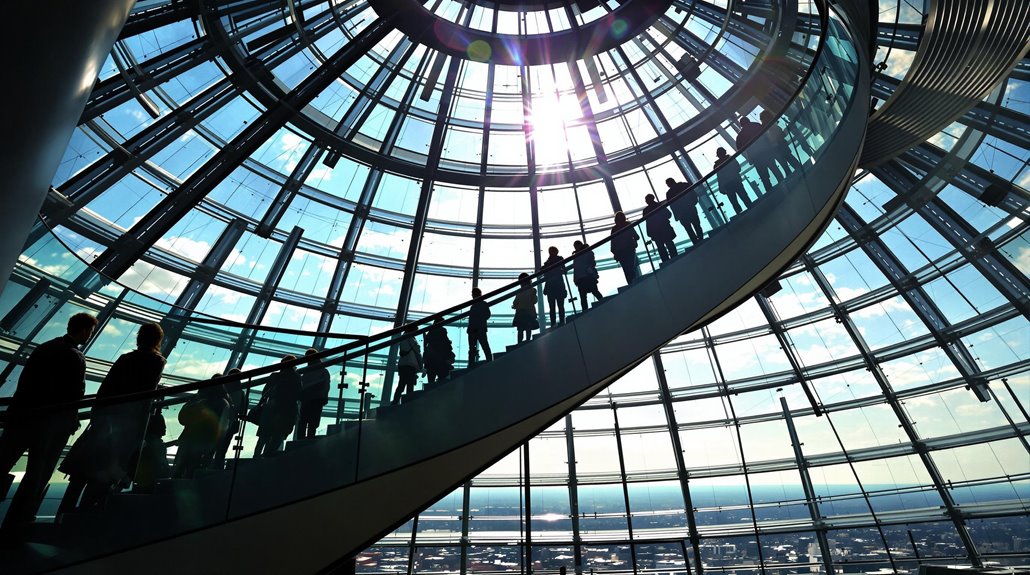
You will discover Berlin's layered history etched into every corner of this once-divided city. From the symbolic Brandenburg Gate to the graffiti-covered remnants of the Wall, each landmark tells a compelling story of triumph and transformation. While tourist hotspots can strain your wallet, many of Berlin's most significant sites offer free or low-cost entry. Whether you're a history buff or casual explorer, these 15 essential locations will help you understand Berlin's complex past and lively present.
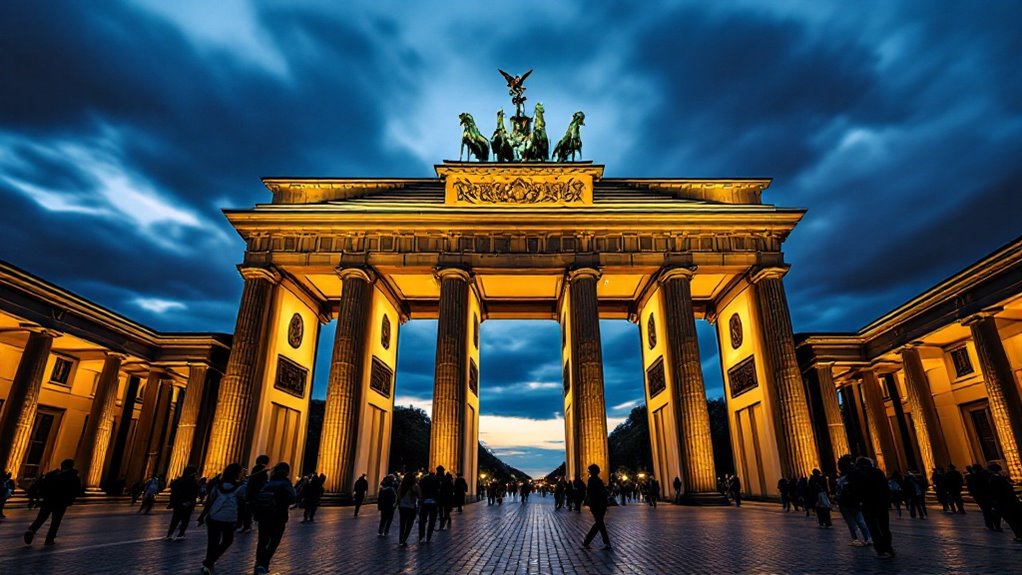
Standing majestically at the heart of Berlin, the Brandenburg Gate serves as Germany's most iconic symbol of unity and perseverance.
You'll marvel at this 26-meter-high neoclassical monument, commissioned in 1788 and inspired by Athens' Acropolis.
Towering 26 meters, this majestic neoclassical masterpiece draws inspiration from ancient Greece, standing as a testament to architectural grandeur.
You can explore the gate's rich history through free audio tours in 15 languages.
Don't miss the famous Quadriga statue atop the structure, a replica of the original that Napoleon once seized.
While you're there, walk through any of the five passages beneath its twelve Doric columns, and imagine the countless historical moments that unfolded here – from Cold War division to the jubilant celebrations of German reunification in 1989.
Visit at night to see the gate beautifully illuminated by LED lights, and consider timing your visit during the annual New Year's Eve celebration.
The gate's enduring legacy includes witnessing Napoleon's march through after defeating Prussia in 1806.
Nestled in the heart of Berlin's historic center, Museum Island showcases five world-renowned museums that'll transport you through millennia of human civilization.
These UNESCO-listed buildings, constructed between 1830-1930, represent the evolution of museum architecture.
You'll discover ancient treasures like the massive Pergamon Altar, the lively Ishtar Gate, and the famous bust of Queen Nefertiti.
The Altes Museum's Greek and Roman collections, including the Berlin Goddess, offer insights into classical antiquity.
For art enthusiasts, the Alte Nationalgalerie displays impressive 19th-century European works, while the Bode Museum houses remarkable Byzantine art.
The new James Simon Gallery serves as your starting point, with convenient underground access to four museums via the Archaeological Promenade.
Each museum's architecture perfectly complements its collections, making Museum Island a must-visit destination for history buffs.
Berlin's rich cultural heritage sites continue to attract millions of visitors annually, cementing its position as a premier tourist destination.
King Frederick William IV of Prussia made a significant contribution when he dedicated the island to art in 1841.
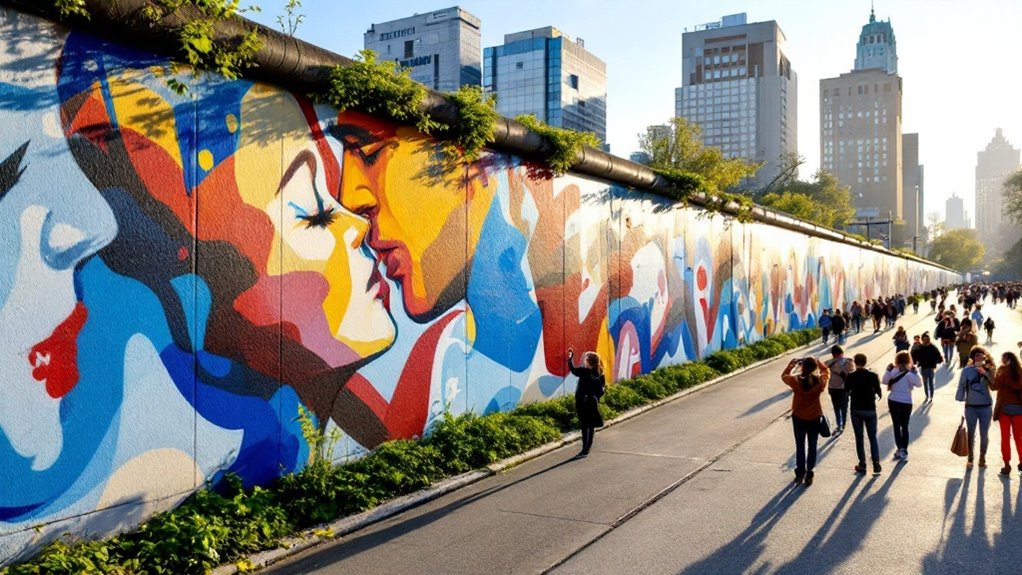
A lively stretch of history adorns Berlin's longest surviving Wall section, where the 1.3-kilometer East Side Gallery transformed a symbol of division into the world's largest open-air gallery.
Created in 1990 after the fall of the Berlin Wall, this free outdoor museum features over 105 murals by international artists expressing themes of peace, freedom, and social justice.
You'll discover iconic works like the "Fraternal Kiss" between Brezhnev and Honecker, and the "Trabi Breaking Through" along the former inner wall that once faced East Berlin.
To reach this protected monument, take the S-Bahn to either Warschauer Straße or Ostbahnhof stations.
While you can visit year-round, arrive early to avoid midday crowds and get unobstructed views of the artwork that symbolizes post-Cold War optimism. The gallery attracts three million visitors annually, making it one of Berlin's most popular cultural landmarks.
Perched atop Berlin's historic parliament building, the Reichstag's glass dome offers visitors a free yet profound glimpse into Germany's commitment to democratic transparency.
The Norman Foster-designed structure, completed in 1999, features a double-helix ramp that you'll climb for spectacular 360-degree views of Berlin from 40 meters up.
Spiral upward along Foster's ingenious double-helix design to experience breathtaking panoramic views of Berlin's sprawling cityscape.
You'll need to plan ahead by registering online for your free visit, and don't forget your photo ID for security.
Once inside, grab one of the complimentary audio guides available in 12 languages to learn about the visible landmarks and the building's transformation from 1894 to today.
If you're interested in German politics, time your visit to peek into the parliamentary chamber below through the dome's mirrored cone, which also cleverly channels natural light into the space. The dome's innovative sun shield tracking system automatically adjusts to block direct sunlight while maintaining optimal visibility throughout the day.
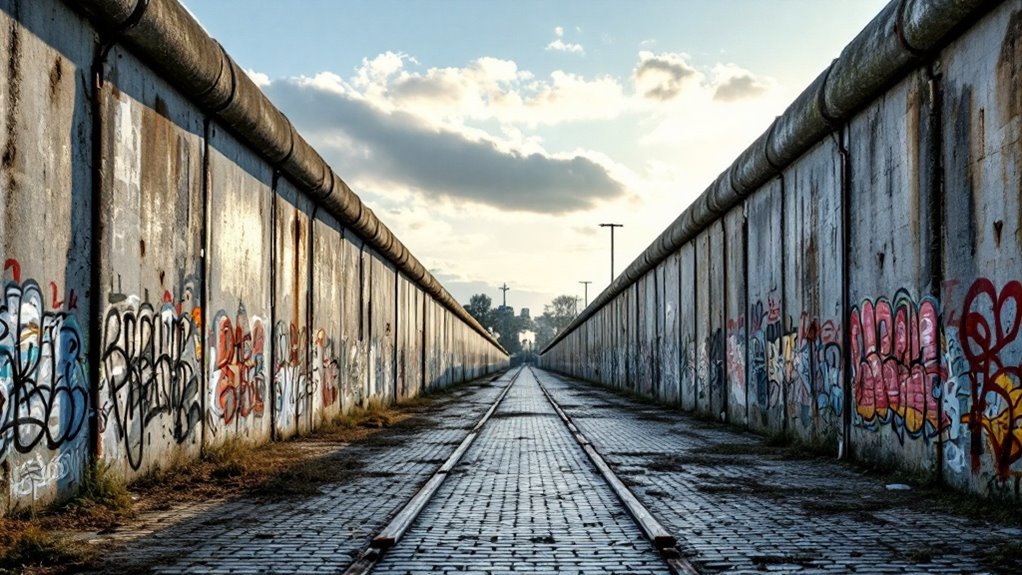
While the Reichstag symbolizes Germany's modern democracy, the Berlin Wall Memorial on Bernauer Straße tells a sobering story of the city's divided past.
You'll walk through 60 meters of preserved border strip, complete with watchtowers and anti-vehicle trenches that show the brutal reality of Cold War Berlin.
Don't miss the Documentation Center's exhibits about the Wall's history and personal accounts of divided families.
The Window of Remembrance honors over 130 victims who died attempting to cross, while the Chapel of Reconciliation stands where a church was demolished during the division. The Chapel features a unique design with an oval wooden rod facade that incorporates materials from the original Versöhnungskirche.
Best of all, entry is free, though guided tours cost €3.50.
Visit between 10 AM and 6 PM Tuesday through Sunday for indoor exhibitions, but you can explore outdoor areas from 8 AM until 10 PM.
Take the S-Bahn to Nordbahnhof station.
Tempelhof's transformation from Nazi-era airport to Berlin's largest public park stands as a demonstration to the city's ability to reinvent itself.
You'll walk on the same runways that once saved West Berlin during the 1948-49 Airlift, when Allied planes delivered essential supplies during the Soviet blockade.
For €16.50, you can join guided tours exploring the terminal's massive limestone façades, underground tunnels, and hangars where forced laborers once worked during WWII.
The free public park spans 386 hectares, perfect for cycling, picnicking, or flying kites on the historic airfield. The building's design, resembling an eagle in flight, makes it one of the most striking examples of airport architecture worldwide.
Don't miss the sunset views from the beer gardens along Columbiadamm, or the memorial at Platz der Luftbrücke honoring the Airlift pilots.
Visit during summer to catch cultural festivals and concerts on the former tarmac.
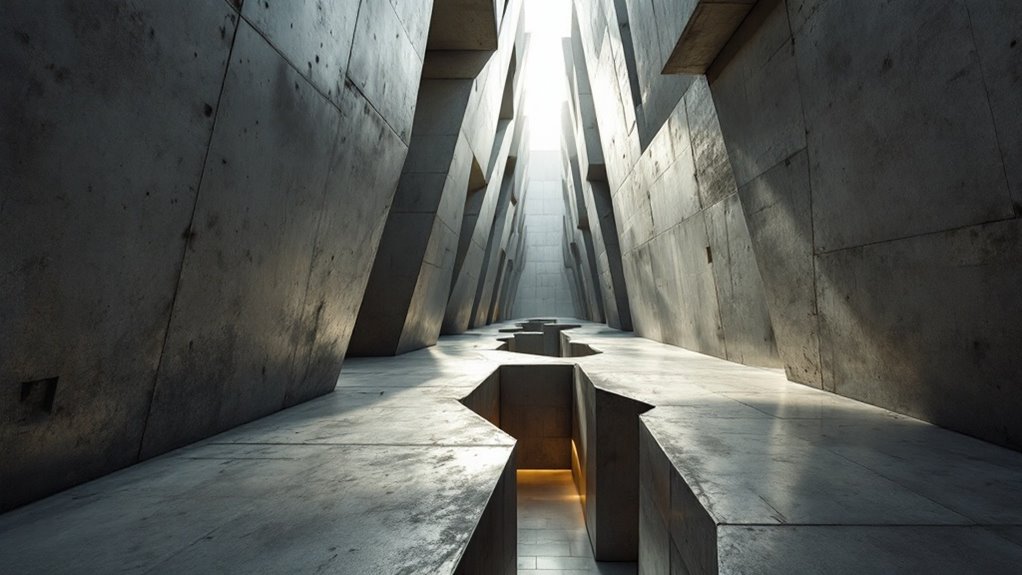
Berlin's most provocative architectural statement, the Jewish Museum combines a 1735 Baroque building with Daniel Libeskind's striking zinc-clad extension.
You'll navigate through underground "Axes" pathways that symbolize Jewish emigration and the Holocaust, leading to the main 15,000 m² Libeskind Building.
Don't miss the Holocaust Tower, a chilling 24m-tall concrete silo with a single light slit, or the Garden of Exile with its 49 tilted pillars.
The museum houses over 100,000 media items in its library dedicated to Jewish life in Germany and abroad.
The Memory Void's installation of 10,000 steel faces and deliberately slanted floors create a powerful sense of disorientation.
Best of all, the core exhibition is free to explore, with paid entry (€8) only for temporary exhibitions.
Pick up a multilingual audio guide to fully understand the building's symbolic features and historical significance.
It's consistently ranked among Germany's top five most-visited museums.
From memorials to living history, the DDR Museum offers an unvarnished look at daily life behind the Iron Curtain.
You'll experience East German society through interactive exhibits, including a fully furnished WBS 70 tower block apartment where you can explore rooms and try on period clothing.
Step into a Trabant P601 for a simulated drive through East Berlin's streets, or visit the surveillance room to understand the Stasi's monitoring tactics.
The museum divides into three main areas covering public life, state ideology, and residential living across 1,000+ square meters. With over 300,000 objects in its collection, the museum provides an extensive look into GDR culture and history.
At €9.80 per adult, you'll get full access to exhibits running daily from 9:00-21:00.
Don't miss the Berlin Wall diorama with its original segment, or the prison cell recreation that powerfully illustrates the era's political repression.
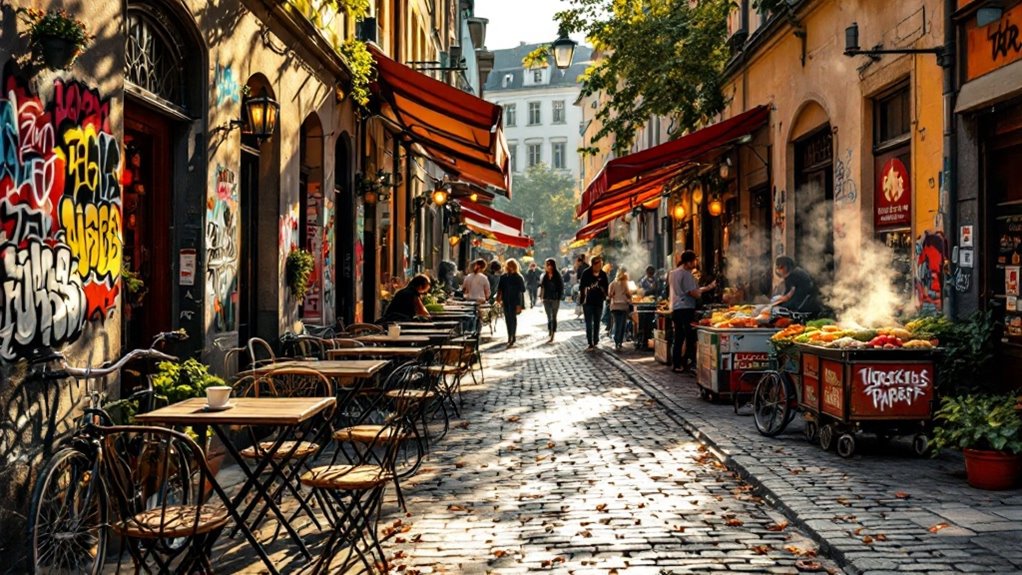
Three major cultural forces shaped Kreuzberg's street art scene: the 1970s punk movement, Turkish immigration, and the district's position along the Berlin Wall.
You'll discover this history alive in SO36, the legendary club where Iggy Pop and David Bowie once performed, and along Oranienstraße, where Turkish markets pulse with energy. The area became a melting pot of cultures with over 31 percent of residents being non-German citizens.
Start your exploration at Mariannenplatz, where street art tours explain the political messages behind lively murals. The neighborhood's culinary diversity reflects its multicultural heritage, with food stalls and restaurants lining the streets.
Don't miss the dense graffiti displays in Haus Schwarzenberg alley or Victor Ash's iconic Astronaut mural.
For contemporary art, visit Urban Spree Gallery in a converted industrial space, or time your visit during Open-Air Gallery Nights to access private studios.
Watch for MyFest on May 1st, when anti-gentrification protests merge with music festivals, offering a glimpse into Kreuzberg's activist spirit.
While Kreuzberg pulses with modern street culture, the majestic Berlin Cathedral stands as a symbol to Prussia's imperial grandeur.
Built between 1894-1905, this Baroque Revival masterpiece features a striking 114-meter-high dome that you can climb for panoramic views of Museum Island. Originally serving as the court and cathedral church of the Hohenzollern dynasty, it represented the peak of imperial power.
Soaring 114 meters above Museum Island, the Berlin Cathedral's magnificent dome beckons visitors to experience breathtaking city panoramas.
For €10, you'll explore the Hohenzollern Crypt, where 90 royal family members rest in ornate sarcophagi.
Don't miss the cathedral's showstopping Sauer Organ with its 7,000 pipes, or the white marble-and-onyx altar beneath restored dome mosaics.
If you're up for it, climb 270 steps to the dome's viewing platform – there's no elevator, but the city views are worth it.
Visit Monday through Friday (9 AM-6 PM), Saturday (9 AM-5 PM), or Sunday (12 PM-5 PM).
Budget travelers can opt for self-guided audio tours to learn about its war damage and 2002 restoration.
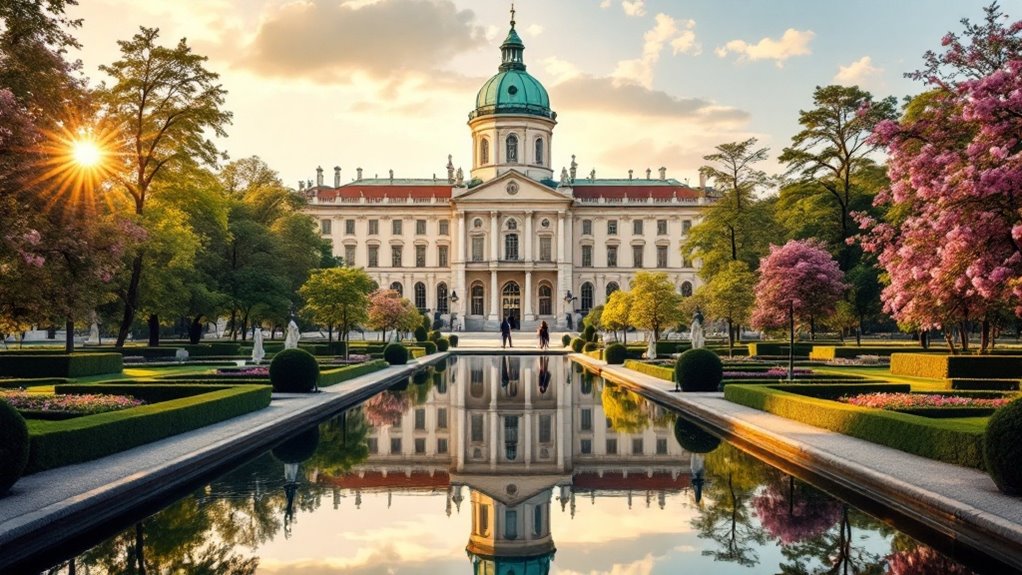
Grandeur meets Baroque splendor at Charlottenburg Palace, Berlin's largest surviving royal residence.
Originally built in 1695 as Sophie Charlotte's summer home, the palace endured WWII bombing damage but has been masterfully restored to its former glory. The estate was built to honor the first Queen of Prussia, Sophie Charlotte, who was highly regarded for her cultural influence.
One will discover a fascinating blend of Baroque and Rococo styles, complete with gilded interiors and one of Europe's finest collections of 18th-century French paintings.
For the budget-conscious traveler:
Don't miss the stunning Porcelain Cabinet with its blue-and-white Chinese ceramics, or the New Wing's Golden Gallery.
Time your visit for seasonal events like the Christmas market or Orangery concerts for an extra-special experience.
Standing as a monument to Berlin's rebirth, Potsdamer Platz transformed from a Cold War no-man's land into one of Europe's most ambitious urban renewal projects.
You'll discover this historic spot just 2 km from the Brandenburg Gate, making it an easy addition to your walking tour.
The area's centerpiece, the Sony Center, features a stunning 102-meter glass-steel tent roof that's particularly photogenic at night.
Don't miss the free panoramic city views from Kollhoff Tower's observation deck or the bustling Arkaden mall if you need a shopping break.
Film buffs should time their visit during the Berlin International Film Festival, when the plaza becomes a red-carpet venue.
For budget travelers, simply walking through the public spaces and admiring the contrasting architecture of modernist glass and traditional brick makes for a worthwhile visit.
The development was divided into four major sections, with Daimler-Benz receiving the largest portion under architect Renzo Piano's vision.
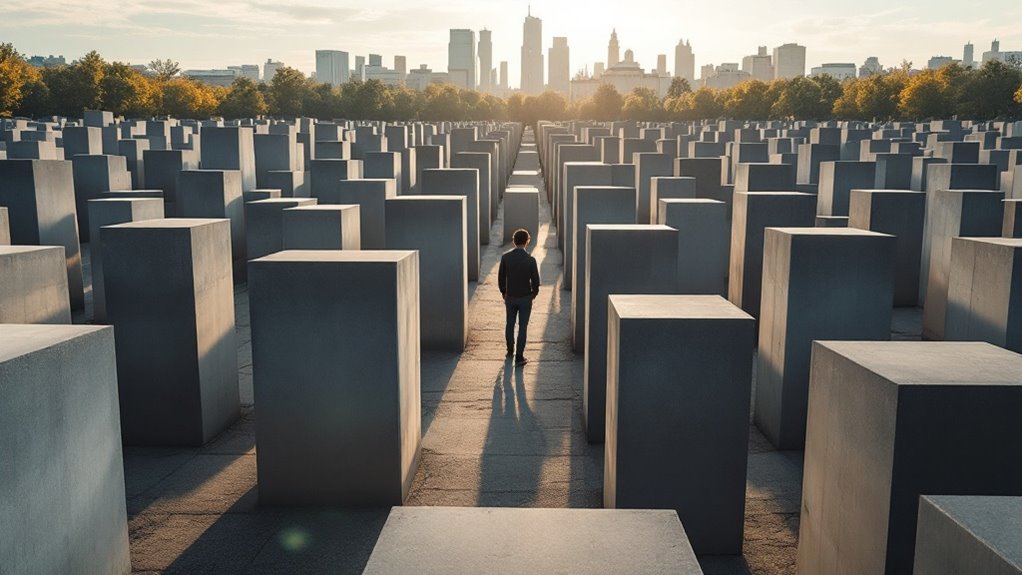
Silence envelops you among the 2,711 concrete stelae of Berlin's Holocaust Memorial, a sprawling open-air monument near the Brandenburg Gate. The site honors six million European Jews who perished during the Holocaust.
The memorial's undulating terrain and varying pillar heights (0.2m to 4.7m) create a disorienting wave pattern that'll make you reflect on the magnitude of the Holocaust.
The free-to-visit memorial includes an underground Information Center where you can:
Visit between 10am-7pm (closed Mondays) to explore the Information Center.
Rent an audio guide for €3.50 in eight languages.
From its soaring observation deck at 203 meters, Berlin's TV Tower offers the city's most expansive views, stretching up to 42 kilometers on clear days.
You'll discover coin-operated telescopes to zoom in on the cityscape's details, while the bar serves drinks alongside breathtaking panoramas.
Built between 1965 and 1969 as a GDR telecommunications project, this iconic structure symbolizes both East German ambition and unified Berlin's spirit. Two high-speed lifts whisk visitors to the sphere in just 40 seconds.
Rising from Cold War division, Berlin's TV Tower stands as a testament to innovation and the city's journey toward unity.
While the revolving restaurant is closed for renovations until spring 2025, you can still make the most of your visit by arriving during off-peak hours – early weekday mornings or late evenings are best.
Plan for about an hour to explore, and don't forget to check out the "Berlin's Odyssey" VR experience for an interactive historical tour.
The Berlin WelcomeCard offers discounted admission and transport combinations.
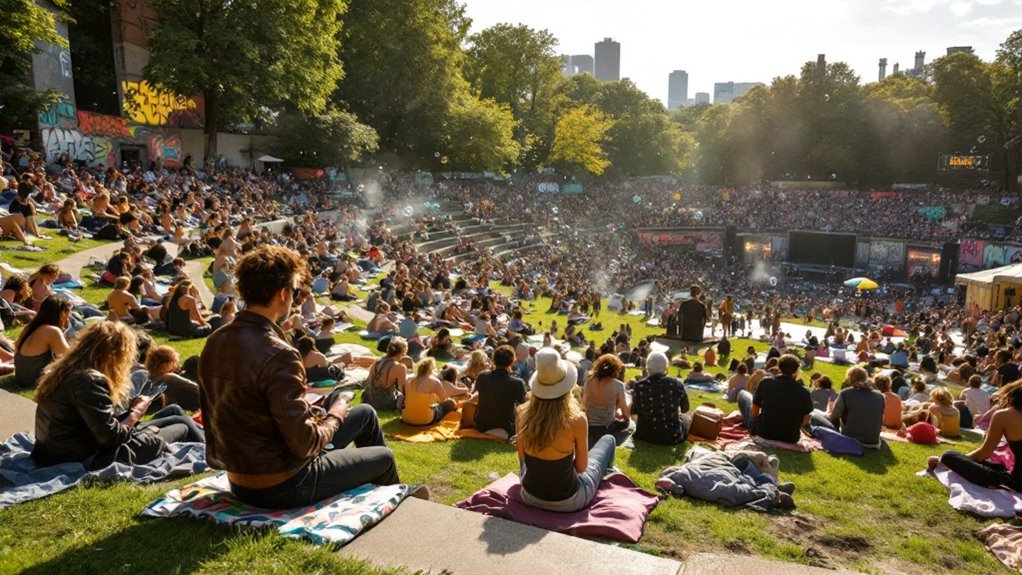
Where else can you experience Berlin's most bustling weekly gathering than at Mauerpark's legendary Sunday festivities? Built on the former Berlin Wall "death strip," this lively space perfectly captures the city's transformation from Cold War division to creative expression.
These unforgettable places to explore have made Mauerpark one of Berlin's most cherished weekend destinations.
From 9 AM to 6 PM, you'll discover over 170 stalls packed with affordable treasures:
Don't miss the famous Bearpit Karaoke at 3 PM, where hundreds gather to watch brave performers tackle everything from rock ballads to hip-hop. Host Joe Hatchiban helps performers shine with tips for dramatic moments and air guitar solos.
While exploring, take time to appreciate the graffiti-covered Wall section and educational plaques that tell the story of this historic site's remarkable journey.
Berlin's rich history doesn't have to drain your wallet. You will discover many of these iconic sites offer free admission or budget-friendly options. Don't skip the free walking tours around the Brandenburg Gate and East Side Gallery, where local guides share compelling historical insights. Pack a picnic for Mauerpark, take advantage of Museum Island's combination tickets, and visit the Reichstag Building by booking your free tour online in advance.